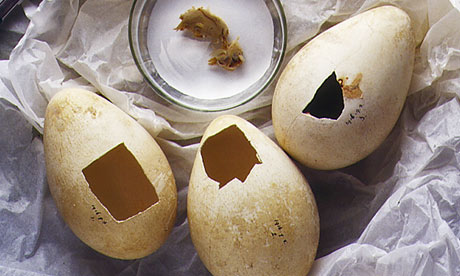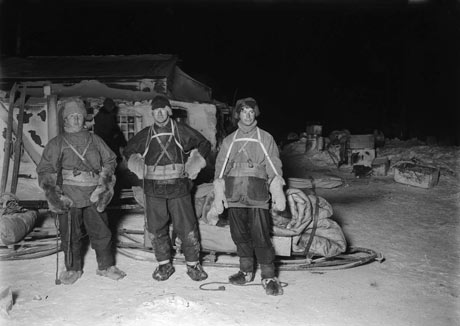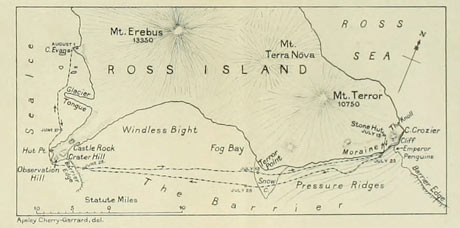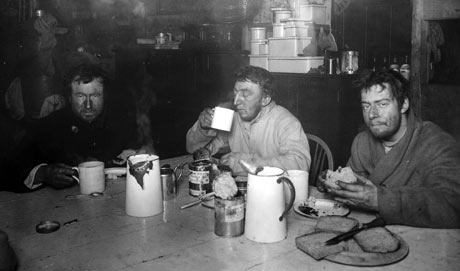Name: Cherry's eggs
Species: Emperor penguin (Aptenodytes forsteri)
Date: 1911
Claim to fame: A reminder of the worst journey in the world
Species: Emperor penguin (Aptenodytes forsteri)
Date: 1911
Claim to fame: A reminder of the worst journey in the world

The three emperor
penguin eggs collected at Cape Crozier have survived more than 100 years
and travelled more than 25,000km. Photograph: Natural History Museum
The date is 27 June 1911 and the setting is Cape Evans in the Antarctic during Robert Falcon Scott's Terra Nova expedition. Three men - Edward Wilson, Henry "Birdie" Bowers and Apsley Cherry-Garrard (aka Cherry) - leave the expedition base behind and head out into the pitch-black of the Antarctic winter. Their destination is an emperor penguin rookery at Cape Crozier, more than 100km away. The purpose of the trip is to collect some eggs with a view to taking a look at their embryonic contents.
Why go to such lengths for a few scrawny penguin chicks with bulbous, unseeing eyes? At a time when the molecule of heredity - DNA - had yet to be identified, the theory of recapitulation (essentially that an embryo takes the various forms of its evolutionary anc
+/1 estors in sequence as it develops) still had its followers. Wilson, the Terra Nova's chief zoologist, was among them. He bought into the idea that the emperor penguin was one of the most primitive birds alive, and believed that an embryonic emperor might provide evidence for a link between dinosaurs and birds. "The earliest bird, the Archaeopteryx, had teeth," Wilson told his fellow explorers before he left the hut at Cape Evans (see his Lecture on Penguins). "One hopes to find real teeth in the embryo of the emperor penguin, though none are present in the adult bird."
If Wilson was to get his mittens on this coveted prize, he would need to strike out in the depths of the Antarctic winter when the eggs were being incubated. This was dangerous in the extreme and Scott had his reservations. "This winter travel is a new and bold venture," he wrote, "but the right men have gone to attempt it." Wilson was certainly tough enough to undertake a round trip of more than 200km in temperatures that frequently fell below -70C with little more than moonlight to guide them, but even he cannot have anticipated just how hard it would be
.
 `o
`oHenry Bowers, Edward Wilson and Apsley Cherry-Garrard (from left to right) on 5 July 1911 before leaving for Cape Crozier. Photograph: Popperfoto/Getty Images
At times they were unable to haul both sledges together. They had to uncouple them and drag them one at a time, which meant trudging back and forth; thee miles travelled for one mile gained. Their sweat froze inside their clothes; their breath iced their balaclavas to their heads; over and over they fell into crevasses. So horrific was the outward leg that by the time they reached Cape Crozier 19 days later, Cherry was ready to give up. "I for one had come to that point of suffering at which I did not really care if only I could die without much pain," he wrote in The Worst Journey in the World.
Looking down from the foothills of Mount Terror on the eastern edge of Ross Island, Cherry described the frozen Ross Sea as "white and peaceful as though such things as blizzards were unknown … God! What a place!" Somewhere out there, the embryonic penguins were waiting. When they finally reached the colony the light (such as it was) was fading fast. "The disturbed Emperors made a tremendous row, trumpeting with their curious metallic voices," wrote Cherry. Keen to avoid being caught out on the sea ice at night, they had to rush, collecting five eggs, skinning three adults for their blubber and legging it back to a half-finished igloo they'd made as a camp. Cherry's pickings – two eggs – cracked en route.
The blizzard that came that night raged for several days: "The indescribable fury and roar of it all cannot be imagined," wrote Cherry. It was a miracle they made it back alive. "Good God! Here is the Crozier Party," was the stunned reaction when Wilson, Bowers and Cherry staggered back to base after an absence of five weeks.

Apsley Cherry-Garrard’s map of the Winter Journey, as it appears in The Worst Journey In the World. Photograph: Internet Archive
The three remaining eggs were intact but frozen solid, the shells "of a bluish white shade, much discoloured by stains". Wilson thawed them out, cut little windows in each shell and was thrilled to find the penguins (which he pickled) in an advanced stage of development.
The following year, in March 1913, Wilson and Bowers perished along with the rest of Scott's party on the return journey from the South Pole, leaving Cherry the guardian of the three precious eggs. He took the responsibility seriously, taking them to the Natural History Museum in South Kensington in person.
In Cherry's retelling – in the third person as the "Heroic Explorer" – he received anything but a hero's welcome. "What do you want? This ain't an egg-shop," spat one custodian. A more senior colleague took the eggs but brushed off Cherry's demands for a receipt. "It is not necessary: it is all right. You needn't wait." But after what he'd endured to get the eggs, Cherry was going nowhere without one. When the receipt finally materialised, he imagined the Heroic Explorer accosting the custodian "(mostly with his boots) by way of teaching him manners ."
With Cherry's persistence, the eggs ended up in the hands of Richard Assheton, an embryologist at Cambridge University. His assistant Dorothy Thursby-Pelham (who would go on to become "England's first female sea-going fisheries scientist") produced a series of beautiful pencil sketches of the intact emperors before Assheton sliced up two of the specimens, mounting sections onto some 800 slides.

Wilson, Bowers and Cherry-Garrard (from left to right) back at the expedition base after their return from Cape Crozier. Photograph: Popperfoto/Getty Images
Unfortunately, Assheton turned up his toes before he could complete his report and the eggs and their diced contents went north again, this time to zoologist James Cossar Ewart at the University of Edinburgh. Following a careful study of the emerging feathers on the embryos, he found evidence that scales and feathers do not have a common origin (as some had supposed). Instead, he envisaged a protobird covered with both scales and feathers that would eventually give rise to true birds in all their feathered glory. Ewart's conclusion: "the worst journey in the world in the interest of science was not made in vain."
Sadly, it probably was. This was certainly the opinion of anatomist Charles Parsons, who wrote a monograph on penguin embryos in 1934, concluding that the Terra Nova specimens "have not contributed much to the understanding of the embryology of penguins". With this frank admission, however, the eggs were suddenly transformed from scientific objects with little future to historical objects of immense power.
The shells, the single intact embryo and the series of microscope slides have survived for more than 100 years and travelled by sled, by ship, by train and by car a distance of more than 25,000km into the care of Douglas Russell, a curator in the Bird Group at the Natural History Museum's country home in Tring, Hertfordshire.
Most of the time, the empty eggs are kept behind the scenes, bedded down on a nest of cotton and foam in a navy blue coffin-like box. Occasionally, however, Russell will lift the lid and give the public a glimpse of these impossibly poignant eggs. One of them is currently on display in the Treasures Cadogan Gallery at the Natural History Museum in South Kensington.
source

















